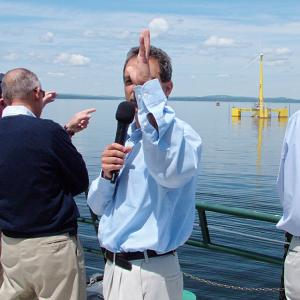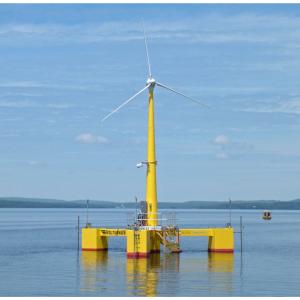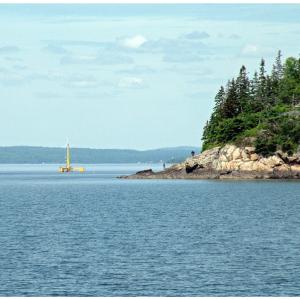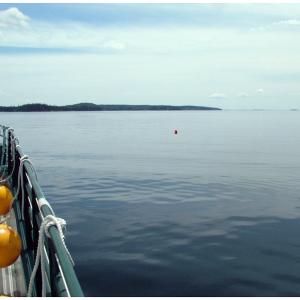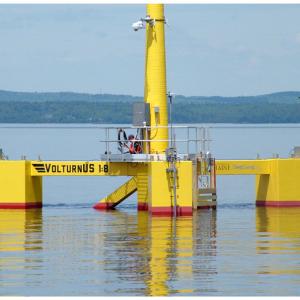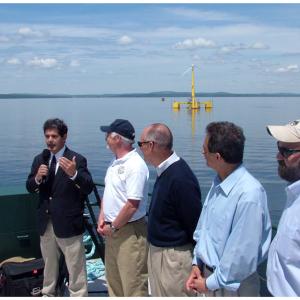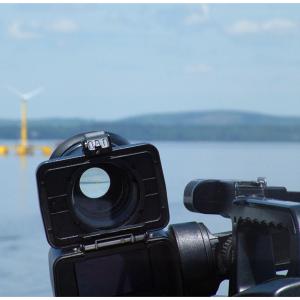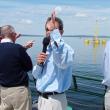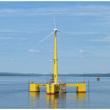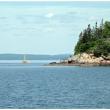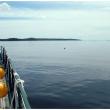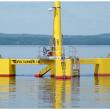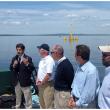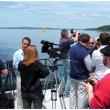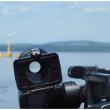UMaine's floating wind turbine plugs into Maine, briefly
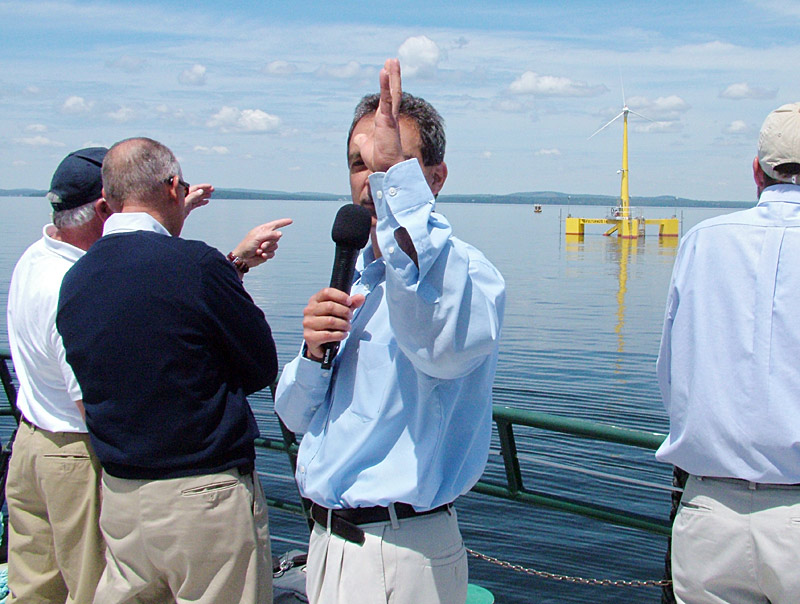 Dr. Habib Dagher, center, of the University of Maine's Advanced Structures & Composites Center, speaks during press conference Thursday marking the ceremonial connection of the first offshore wind turbine in the United States — a 65 foot tall, 1:8 scale prototype, background — to the mainland electrical grid. (Photo by Ethan Andrews)
Dr. Habib Dagher, center, of the University of Maine's Advanced Structures & Composites Center, speaks during press conference Thursday marking the ceremonial connection of the first offshore wind turbine in the United States — a 65 foot tall, 1:8 scale prototype, background — to the mainland electrical grid. (Photo by Ethan Andrews)
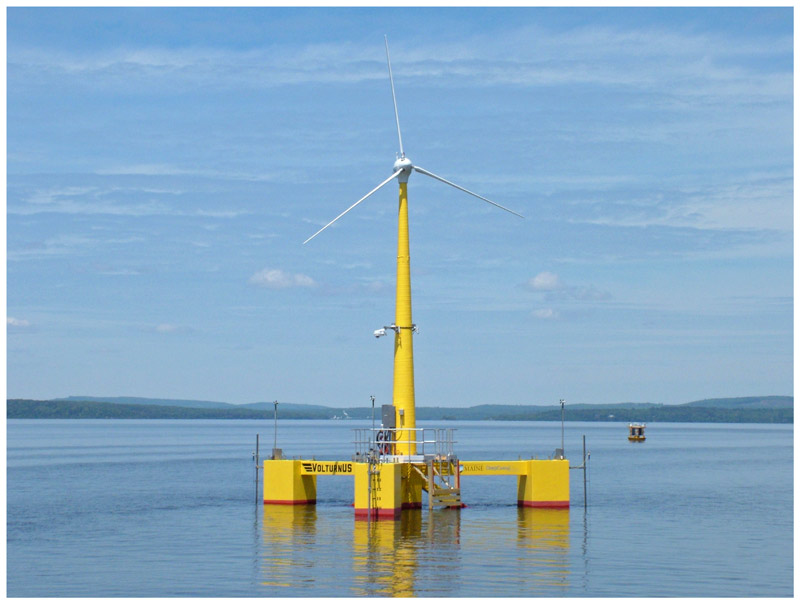 VolturnUS 1:8 was built to model a 6 megawatt turbine, which supporters of the nascent offshore wind energy industry hope will one day populate the Gulf of Maine. (Photo by Ethan Andrews)
VolturnUS 1:8 was built to model a 6 megawatt turbine, which supporters of the nascent offshore wind energy industry hope will one day populate the Gulf of Maine. (Photo by Ethan Andrews)
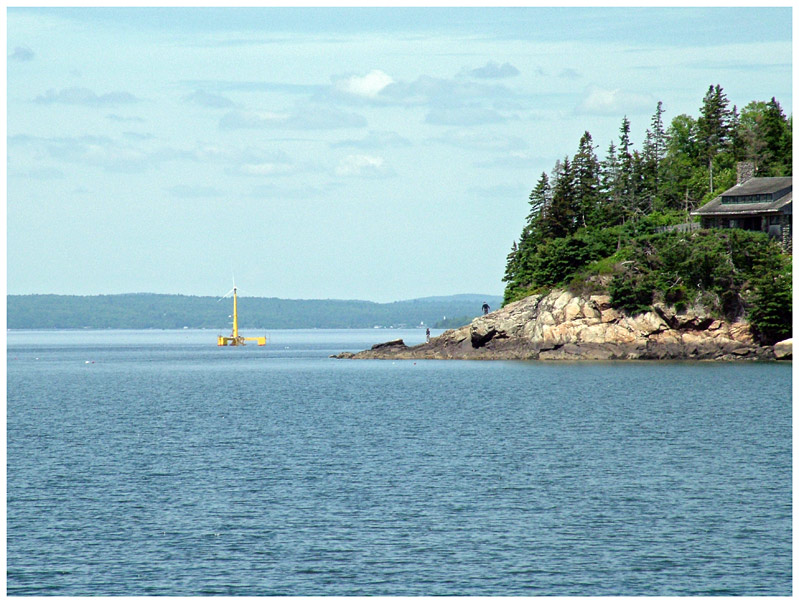 A first glimpse of VolturnUS 1:8, seen on the way out of Castine Harbor. Dyce Head is visible at right. (Photo by Ethan Andrews)
A first glimpse of VolturnUS 1:8, seen on the way out of Castine Harbor. Dyce Head is visible at right. (Photo by Ethan Andrews)
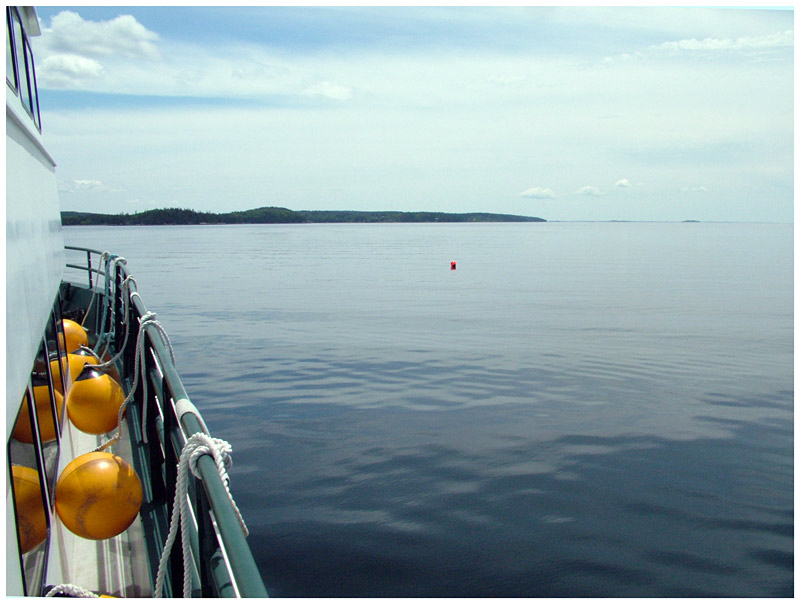 Wind was in short supply Thursday, as evidenced by the glassy waters surrounding Maine Maritime Academy's "Ned" just outside Castine Harbor (Photo by Ethan Andrews)
Wind was in short supply Thursday, as evidenced by the glassy waters surrounding Maine Maritime Academy's "Ned" just outside Castine Harbor (Photo by Ethan Andrews)
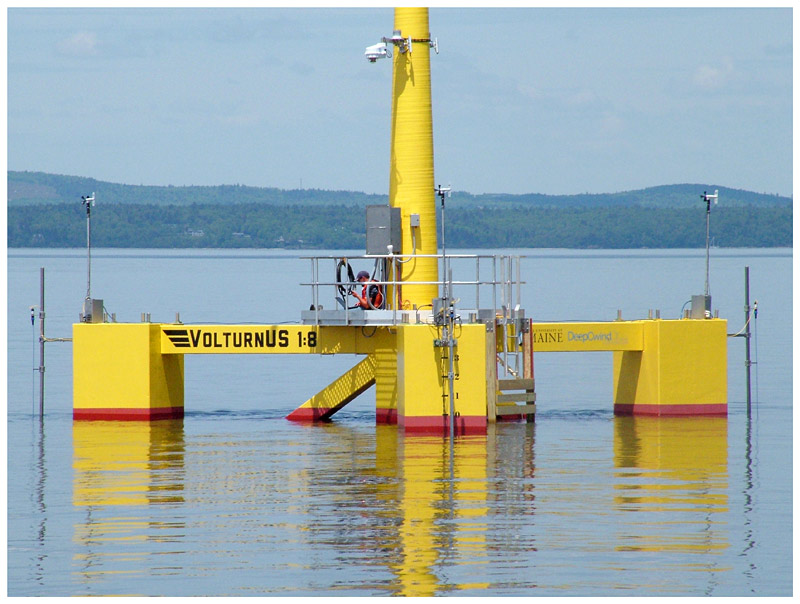 A technician aboard VolturnUS awaits a signal to connect the floating wind turbine to the mainland electrical grid. (Photo by Ethan Andrews)
A technician aboard VolturnUS awaits a signal to connect the floating wind turbine to the mainland electrical grid. (Photo by Ethan Andrews)
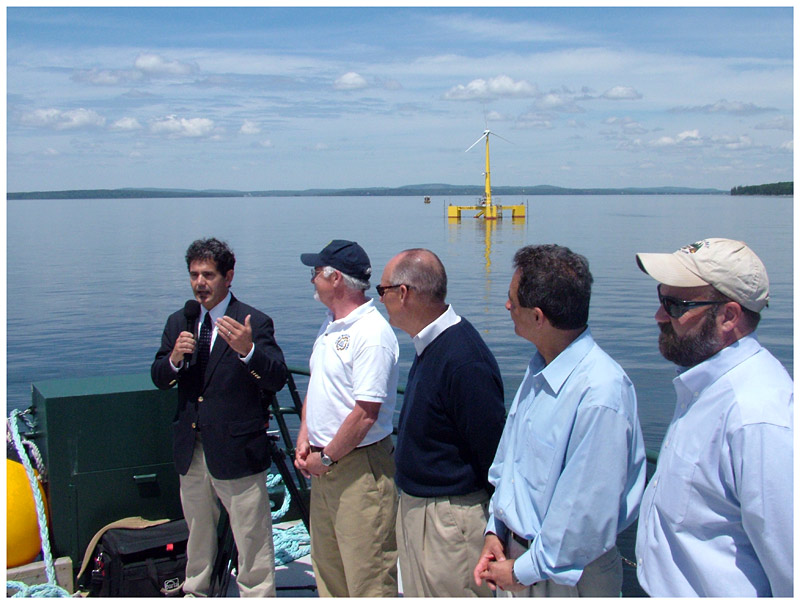 Captain David Gelinas of the Penobscot Bay and River Pilots Association recalls towing VolturnUS by water from Brewer and the six foot swells in the part of the bay near Castine that was so placid Thursday. (Photo by Ethan Andrews)
Captain David Gelinas of the Penobscot Bay and River Pilots Association recalls towing VolturnUS by water from Brewer and the six foot swells in the part of the bay near Castine that was so placid Thursday. (Photo by Ethan Andrews)
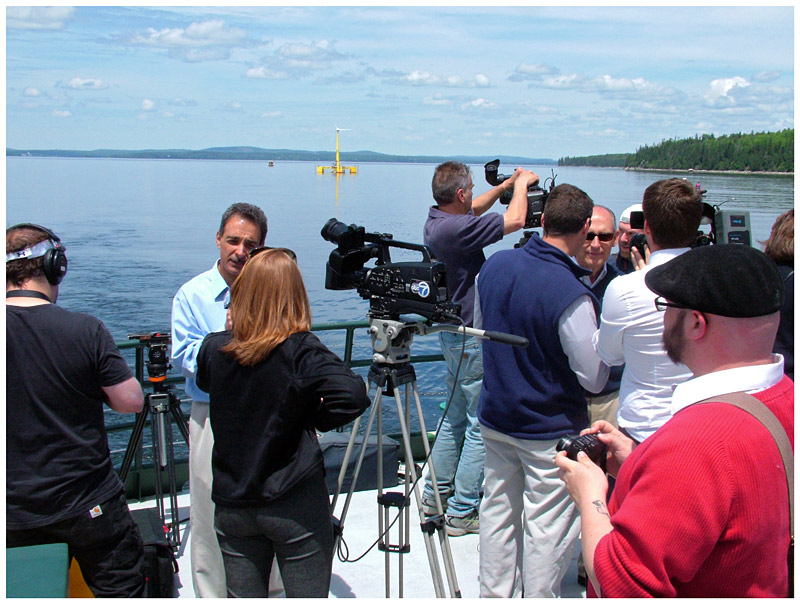 Reporters interview Dr. Habib Dagher, left, and Cianbro CEO and President Peter Vigue, right, with sunglasses. (Photo by Ethan Andrews)
Reporters interview Dr. Habib Dagher, left, and Cianbro CEO and President Peter Vigue, right, with sunglasses. (Photo by Ethan Andrews)
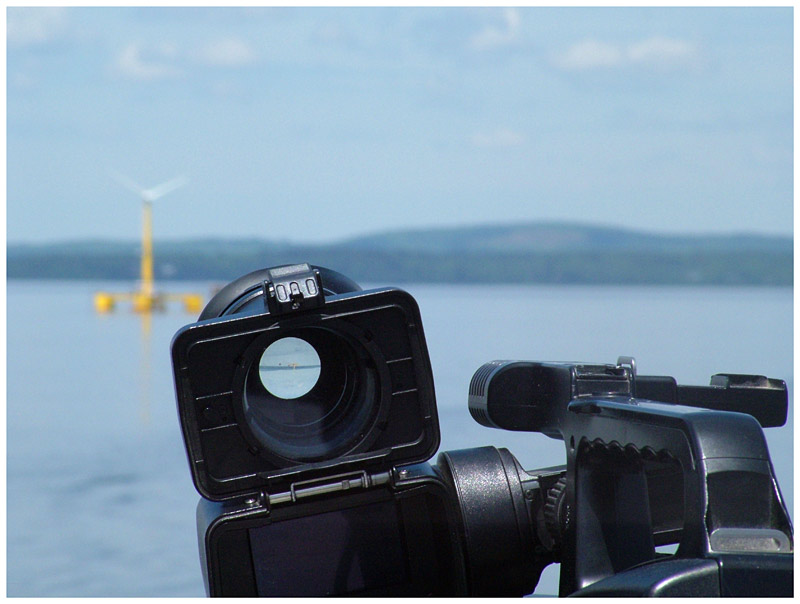 A television camera lens trained on the offshore wind turbine VolturnUS 1:8. (Photo by Ethan Andrews)
A television camera lens trained on the offshore wind turbine VolturnUS 1:8. (Photo by Ethan Andrews)
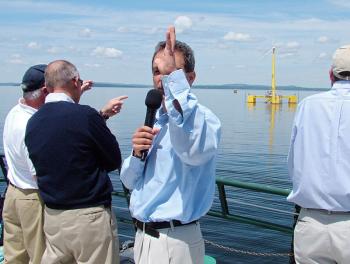 Dr. Habib Dagher, center, of the University of Maine's Advanced Structures & Composites Center, speaks during press conference Thursday marking the ceremonial connection of the first offshore wind turbine in the United States — a 65 foot tall, 1:8 scale prototype, background — to the mainland electrical grid. (Photo by Ethan Andrews)
Dr. Habib Dagher, center, of the University of Maine's Advanced Structures & Composites Center, speaks during press conference Thursday marking the ceremonial connection of the first offshore wind turbine in the United States — a 65 foot tall, 1:8 scale prototype, background — to the mainland electrical grid. (Photo by Ethan Andrews)
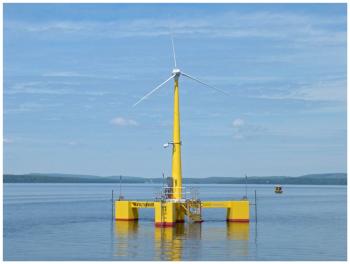 VolturnUS 1:8 was built to model a 6 megawatt turbine, which supporters of the nascent offshore wind energy industry hope will one day populate the Gulf of Maine. (Photo by Ethan Andrews)
VolturnUS 1:8 was built to model a 6 megawatt turbine, which supporters of the nascent offshore wind energy industry hope will one day populate the Gulf of Maine. (Photo by Ethan Andrews)
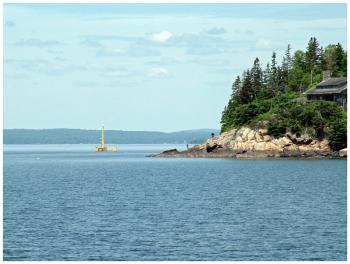 A first glimpse of VolturnUS 1:8, seen on the way out of Castine Harbor. Dyce Head is visible at right. (Photo by Ethan Andrews)
A first glimpse of VolturnUS 1:8, seen on the way out of Castine Harbor. Dyce Head is visible at right. (Photo by Ethan Andrews)
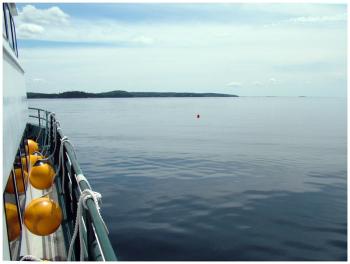 Wind was in short supply Thursday, as evidenced by the glassy waters surrounding Maine Maritime Academy's "Ned" just outside Castine Harbor (Photo by Ethan Andrews)
Wind was in short supply Thursday, as evidenced by the glassy waters surrounding Maine Maritime Academy's "Ned" just outside Castine Harbor (Photo by Ethan Andrews)
 A technician aboard VolturnUS awaits a signal to connect the floating wind turbine to the mainland electrical grid. (Photo by Ethan Andrews)
A technician aboard VolturnUS awaits a signal to connect the floating wind turbine to the mainland electrical grid. (Photo by Ethan Andrews)
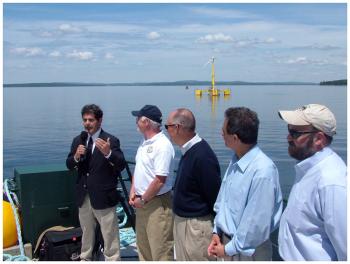 Captain David Gelinas of the Penobscot Bay and River Pilots Association recalls towing VolturnUS by water from Brewer and the six foot swells in the part of the bay near Castine that was so placid Thursday. (Photo by Ethan Andrews)
Captain David Gelinas of the Penobscot Bay and River Pilots Association recalls towing VolturnUS by water from Brewer and the six foot swells in the part of the bay near Castine that was so placid Thursday. (Photo by Ethan Andrews)
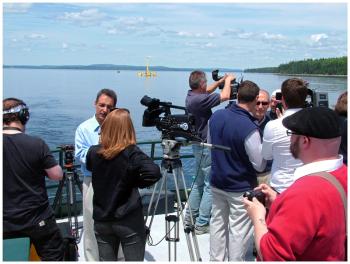 Reporters interview Dr. Habib Dagher, left, and Cianbro CEO and President Peter Vigue, right, with sunglasses. (Photo by Ethan Andrews)
Reporters interview Dr. Habib Dagher, left, and Cianbro CEO and President Peter Vigue, right, with sunglasses. (Photo by Ethan Andrews)
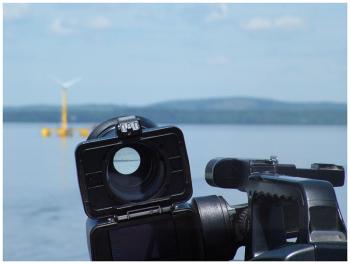 A television camera lens trained on the offshore wind turbine VolturnUS 1:8. (Photo by Ethan Andrews)
A television camera lens trained on the offshore wind turbine VolturnUS 1:8. (Photo by Ethan Andrews)
CASTINE – The Roman god of the east wind could not be summoned in Castine on Thursday. Central Maine Power would have to do.
The occasion was the ceremonial transmission of the first electricity from an offshore wind turbine in the United States to the mainland electrical grid.
On a boat floating in the glassy waters off Dyce Head, a group of Maine's wind energy luminaries shouted "Energize Volturnus!" A short distance away, VolturnUS, a 1:8 scale prototype of a 6 megawatt floating wind turbine (the name is an amalgamation of relevant syllables that collectively spell the name of the aforementioned Roman god) turned to face an undetectable wind. The rotors stirred a bit.
"So, at 12:40 p.m., the first electrons are flowing into the U.S. grid," said Dr. Habib Dagher, director of the University of Maine's Advanced Structures & Composites Center and leader of the DeepC Wind Consortium — a wind energy research initiative funded by the US Department of Energy and National Science Foundation, including roughly 30 partners ranging from universities to utility companies.
The electrons quickly scurried back to the turbine through an underwater cable, along with a mob of their land-based counterparts, setting the blades spinning at power-generating speeds for the benefit of an assembled press corps. It was a beautiful day and there would be no shortage of wind in the deep waters of the Gulf of Maine.
Tests being conducted with VolturnUS 1:8 represent an intermediary step toward DeepC's goal of installing the first full-sized turbine off the coast of Maine by 2016 and deploying enough commercial offshore wind turbines to generate 5 gigawatts of power by 2030.
In this way, the Consortium hopes to make the State of Maine a national leader in deep water offshore wind technology — floating a stone's throw from VolturnUS 1:8 on Thursday, some dared to imagine Maine as an international leader in the field.
"But we have to walk before we run; crawl before we walk," Dagher said.
He likened the first power transmission of VolturnUS 1:8 to the Wright Brothers first successful flight. "It was a small plane," he said, "but they figured out they could fly."
Volturnus is one of only three floating offshore wind turbines in the world and the first in the United States. Statoil, an international energy company based in Norway floated the first deep water turbine Hywind in 2009. The company recently received approvals to build and deploy a test installation of four floating wind turbines, dubbed Hywind Maine, near Boothbay Harbor.
To date, commercial offshore wind farms in Europe, and more recently the U.S., have used use pilings driven into the sea floor to anchor the turbine. Installation and servicing are costly and require specialized equipment. Eliminating these costs is a big part of the reason companies are keeping a close eye on the development of floating turbine technology. As VoltunUS has at least partially demonstrated, floating turbines can potentially be fabricated on land and towed out to sea — or back in for servicing — with nothing more specialized than a tug boat.
VolturnUS also features several material innovations. The base pontoons, which descend iceberg-like below the waterline, are made of concrete. The tower is made of a composite material (fiber reinforced resin). Both materials are more resistant to corrosion than steel, which is the primary material other offshore wind installations. As a result, the UMaine designed turbines would last 75 to 100 years, he said, as compared with the 25-year life span of the two other floating wind turbines in existence today.
Composites are much lighter than steel, so in the case of a 6-megawatt turbine, in which the blades would span a diameter equal to one-and-a-half football fields, Dagher said the turbine would be significantly less top-heavy.
"It's a leap forward," he said.
Also on hand for Thursday's press conference were: Peter Vigue, CEO and president of Cianbro, the Brewer-based company that fabricated VolturnUS 1:8; Jake Ward, UMaine vice president for innovation and economic development; Dr. William Brennan, president of Maine Maritime Academy, where students conducted preliminary research for the project. MMA's tug Pentagöet towed the prototype turbine from Cianbro's Brewer facility to Castine. Captain David Gelinas, who piloted the tug on the 30-mile, 11-hour passage recalled on Thursday that there were swells of up to six feet in the waters off Dyce Head on the day of the transit. Dagher said the waves that day were the equivalent to hurricane swells for the 1:8 scale turbine.
Finding an online description of Volturnus as a wind god isn't easy. More commonly he's listed as god of rivers and water, both of which have played major roles in the life of VoluturnUS 1:8 to date. As far as summoning the wind goes, there's still time to make adjustments.
______________________________________________________________
Ethan Andrews can be reached at news@penbaypilot.com
Event Date
Address
United States

